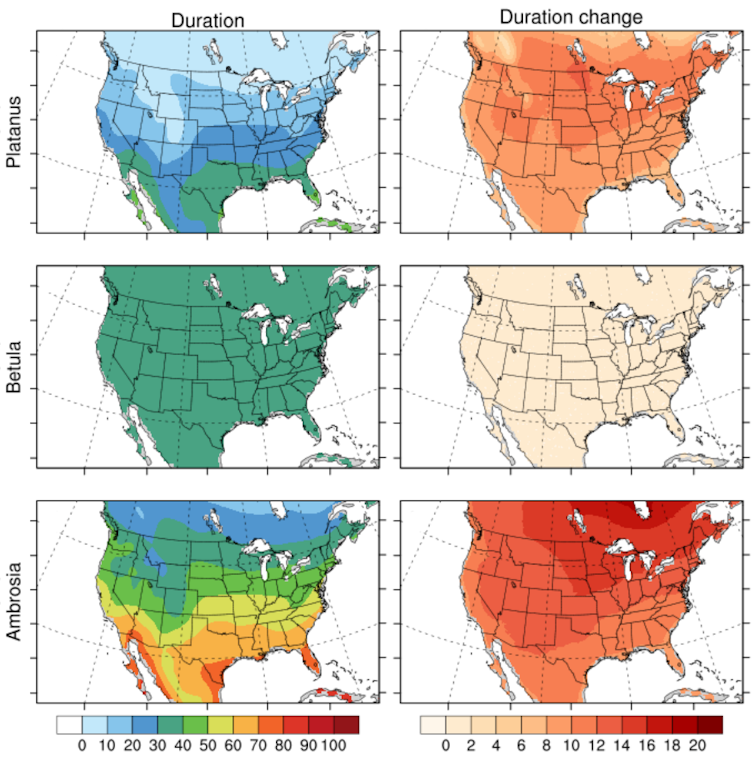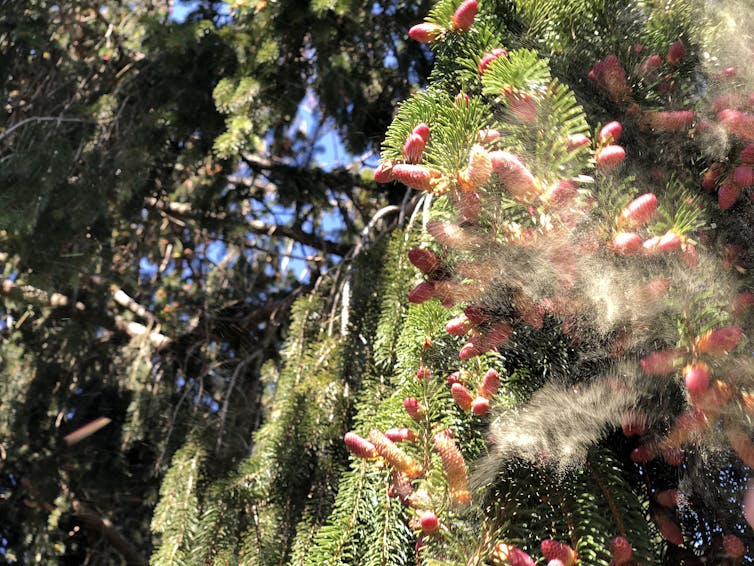We’re creating better pollen forecasts to help
 |
| Allergy season is here. Imgorthand/E+ via Getty Images |
Pollen allergies affect over 30% of the global population, making them a significant public health and economic issue as people feel ill and miss work. Our research shows that, as greenhouse gases warm the planet, their effects are driving longer and more intense pollen seasons.
To help allergy sufferers manage their symptoms in our changing climate, we’re building better pollen forecasts for the future.
As atmospheric scientists, we study how the atmosphere and climate affect trees and plants. In a 2022 study, we found that the U.S. will face up to a 200% increase in total pollen this century if the world continues producing carbon dioxide emissions at a high rate. Pollen season in general will start up to 40 days earlier in the spring and last up to 19 days longer than today under that scenario.
 |
| The maps on the left show the recent average pollen season length in days for three types of plants: Platanus, or plane trees, such as sycamores; Betula, or birch; and Ambrosia, or ragweed. The maps on the right show the expected changes in total days by the end of the century if carbon dioxide emissions continue at a high rate. Zhang and Steiner, 2022 |
While most studies focus on pollen overall, we zoomed in on more than a dozen different types of grasses and trees and how their pollen will affect regions across the U.S. in different ways. For example, species like oak and cypress will give the Northeast the biggest increase, but allergens will be on the rise just about everywhere, with consequences for human health and the economy.
Why pollen is increasing
Let’s start with the basics. Pollen – the dustlike grains produced by grasses and plants – contains the male genetic material for a plant’s reproduction.
How much pollen is produced depends on how the plant grows. Rising global temperatures will boost plant growth in many areas, and that, in turn, will affect pollen production.
Warmer temperatures will extend the growing season, allowing plants to grow and emit pollen for longer periods. But temperature is only part of the equation. We found that a potentially greater driver of the future pollen increase will be rising carbon dioxide emissions from sources such as vehicles and power plants. Carbon dioxide fuels photosynthesis, leading to increased growth and the potential for more pollen production.
 |
| Cones on a Norway spruce in Virginia release pollen. Famartin/Wikimedia, CC BY-ND |
Pollen changes will vary by region
We looked at 15 different pollen types, rather than treating all pollen the same as many past studies have. Our study found that the amount of pollen increase in a specific region depends on the types of vegetation.
Typically, pollination starts with leafy deciduous trees in late winter and spring. Alder, birch and oak are the three top deciduous trees for causing allergies, though there are others, like mulberry.
Grass pollen becomes more prevalent in the summer, followed by ragweed in late summer. In the Southeast, evergreen trees like mountain cedar and juniper (in the cypress family) start in January. In Texas, “cedar fever” is the equivalent of hay fever.
We found that in the Northeast, pollen seasons for a lot of allergenic trees will increasingly overlap as temperatures and carbon dioxide emissions rise. For example, it used to be that maple trees would release pollen first, and then birch would pollinate. Now we see more overlap of their pollen seasons.
In general, pollen season changes are greater in the northern United States than in the South, because of larger temperature increases in northern areas in future climate projections.
Southeastern regions, including Florida, Georgia and South Carolina, can expect large grass and weed pollen increases in the future. The Pacific Northwest is likely to see peak pollen season a month earlier because of the early pollen season of alder.
Allergy problems are already on the rise. A study in 2021 found that the overall pollen season was already about 20 days longer in North America than it was in 1990 and pollen concentrations were up about 21%.
Silver lining: We can improve pollen forecasting
Most pollen forecasts right now provide a very broad estimate of where and when pollen counts will be high. Part of the problem is that there aren’t many observing stations for pollen counts. Most are run by allergy clinics, and there are fewer than 200 of these stations distributed across the country. Michigan, where we live, doesn’t have any that are currently operating.
It’s a very labor-intensive process to measure different types of pollen. As a result, current forecasts have a lot of uncertainties. These likely are based in part on what a station has observed in the past and the weather forecast.
 |
| Pollen sampling for regional forecasts can be labor-intensive. HelenaAnna/Wikimedia, CC BY-ND |
We can estimate where the trees are from satellite data and on-the-ground surveys. We also know how temperature influences when pollen comes out – what scientists call the phenology of the pollen.
With that information, we can use meteorological factors like wind, relative humidity and precipitation to figure out how much pollen gets into the air, and atmospheric models can show how it moves and blows around, to create a real-time forecast.
We’re currently working with a National Oceanic and Atmospheric Administration lab about ways to integrate that information into a tool for air quality forecasting. Our next step is to evaluate these forecast tools and make information available to the public.
 |
| Ragweed pollen grains, magnified and colorized. Bob Sacha/Corbis Documentary via Getty Images |
There are still some unknowns when it comes to long-term pollen projections. For example, scientists don’t fully understand why plants produce more pollen in some years than others, and currently we cannot include these changes in our models.
It’s also not fully clear how plants will respond if carbon dioxide levels go through the roof. Ragweed and residential trees are also hard to capture. There are very few ragweed surveys showing where these plants are growing in the U.S., but that can be improved.
This is an update to an article originally published March 15, 2022.![]()
Yingxiao Zhang, Ph.D. Student in Atmospheric Science, University of Michigan and Allison L. Steiner, Professor of Atmospheric Science, University of Michigan
This article is republished from The Conversation under a Creative Commons license. Read the original article.